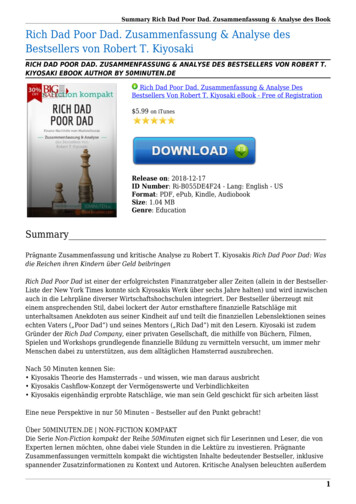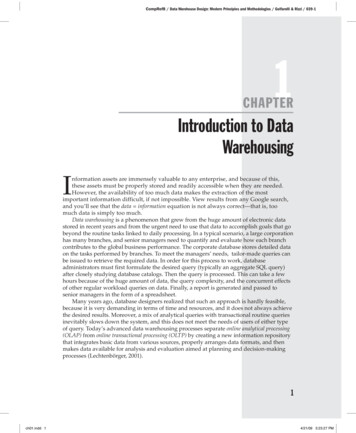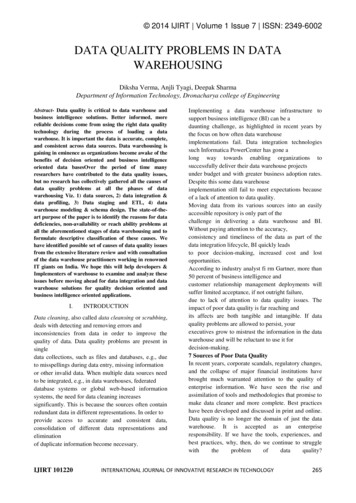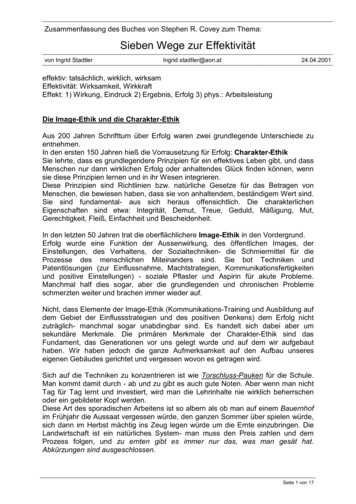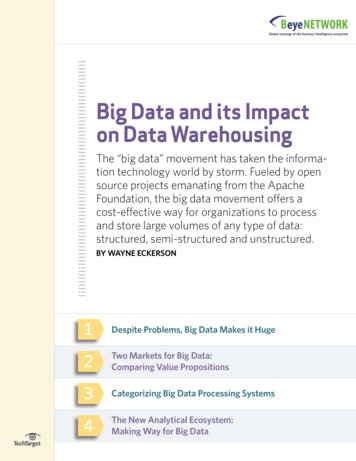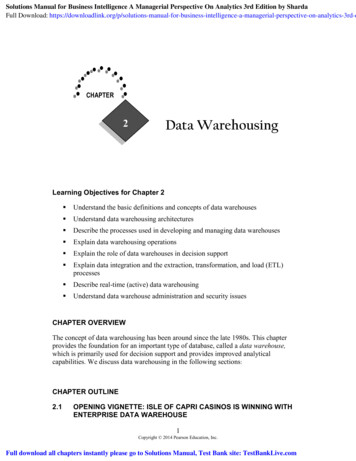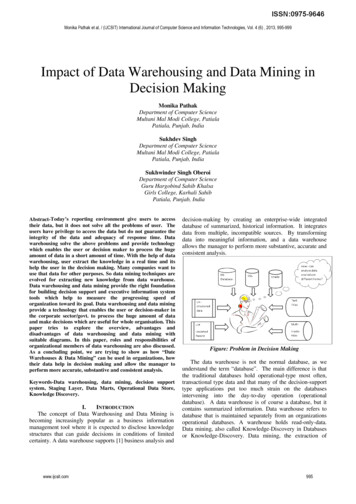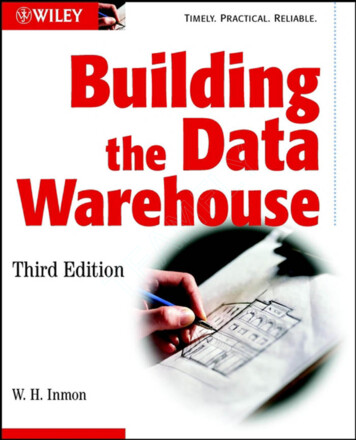
Transcription
Zusammenfassung zur VorlesungData Warehousinggehalten im WS 2003von O. Univ. Prof. Dr. A Min TjoarnFebruar 20041
Contents1 The Compelling Need for Data Warehousing1.1 Data Warehouse Defined . . . . . . . . . . . . . . . . . . . . . . . . . . . .452 Data Warehouse: The Building Blocks2.1 Data Warehouses vs. Data Marts . . . . . . . . . . . . . . . . . . . . . . .2.2 Components of a Data Warehouse . . . . . . . . . . . . . . . . . . . . . .5663 Trends in Data Warehousing3.1 Significant Trends . . . . . . . . . . . . . . . . . . . . . . . . . . . . . . .774 Planning and Project Management4.1 Overview . . . . . . . . . . . . . . . . .4.2 Consideration of Key Issues . . . . . . .4.3 Justifying Your Data Warehouse . . . .4.4 The Initial Stage of the Data Warehouse4.4.1 The Project Team . . . . . . . . . . . . . . . . . . . .Project. . . . .88899105 Defining the Business Requirements115.1 Dimensional Nature of Business Data . . . . . . . . . . . . . . . . . . . . 115.2 Information Packages - a New Concept . . . . . . . . . . . . . . . . . . . . 115.3 User Interviews . . . . . . . . . . . . . . . . . . . . . . . . . . . . . . . . . 126 Requirements as the Driving Force for Data Warehousing6.1 Special Considerations . . . . . . . . . . . . . . . . . .6.2 Tools and Products . . . . . . . . . . . . . . . . . . . .6.3 Data Storage Specifications and DBMS Selection . . .6.4 Tips for Requirements Definition . . . . . . . . . . . .7 The Architectural Components7.1 Technical Architecture . . .7.1.1 Data Acquisition . .7.1.2 Data Storage . . . .7.1.3 Information Delivery.1213141515.15161617188 Infrastructure as the Foundation for Data Warehouses8.1 Operational Infrastructure . . . . . . . . . . . . . .8.2 Physical Infrastructure . . . . . . . . . . . . . . . .8.3 Server hardware options . . . . . . . . . . . . . . .8.4 Selection of the DBMS . . . . . . . . . . . . . . . .8.5 Architecture First, Then Tools . . . . . . . . . . .181819202021.2.
9 The9.19.29.39.49.5Significant Role of MetadataWhy Metadata is Important . . . . . . . . . . . . . . . . . . . . . . . . . .Questions and Issues about Data Warehouse Administration . . . . . . . .Who Needs Metadata? . . . . . . . . . . . . . . . . . . . . . . . . . . . . .Metadata Is Essential for Every Tier of the Data Warehouse ArchitectureHowever, even More Aspects of Metadata . . . . . . . . . . . . . . . . . .22222324252510 Principles of Dimensional Modeling2610.1 Star Schema Modeling . . . . . . . . . . . . . . . . . . . . . . . . . . . . . 2611 Dimensional Modeling: Advanced11.1 Changing Dimensions . . . .11.2 Large Dimensions . . . . . . .11.3 Snowflake schema . . . . . . .Topics27. . . . . . . . . . . . . . . . . . . . . . . . . 27. . . . . . . . . . . . . . . . . . . . . . . . . 28. . . . . . . . . . . . . . . . . . . . . . . . . 2812 Data Extraction, Transformation, and Loading12.1 Major Tasks in the ETL Process . . . . . .12.2 Data Extraction . . . . . . . . . . . . . . .12.3 Data Transformation . . . . . . . . . . . . .12.4 Data Loading . . . . . . . . . . . . . . . . .292929303013 Data Quality: A Key to Success3113.1 Data Cleansing . . . . . . . . . . . . . . . . . . . . . . . . . . . . . . . . . 3314 Matching Information to the Classes of Users3314.1 Data Warehouse User Classes . . . . . . . . . . . . . . . . . . . . . . . . . 3415 OLAP in the data warehouse353
1 The Compelling Need for Data WarehousingEnterprises do need strategic information for many reasons. They often do have mountains of data which is spread across many types of incompatible structures and systems.Hence the available data is not readily usable for strategic decision making. OLTP (online transaction processing), the operational data and the informational data needed foranalysis can be compared as follows: Operational systems– Take an order– Process a claim– Make a shipment Informational (decision support) systems– Show me the top selling products– Show me the problem regions– Show the highest margins– Tell me why (drill down)– Let me see other data (drill across)– Alert me when a district sells below targetTable (1) on page (4) lists the most important differences between transaction andanalysis data. Processing requirements in the data warehouse environment:Data ContentData StructureAccess FrequencyAccess TypeUsageResponse TimeUsersoperationalCurrent ValuesOptimized for transactionsHighRead, update, deletePredictable, repetitiveSub-secondsLarge numberinformationalArchived, derived, summarizedOptimized for complex queriesMedium to lowReadAd hoc, random, heuristicSeveral seconds to minutesRelatively small numberTable 1: Differences between operational and informational data1. Running of simple queries and reports against current and historical data2. Ability to perform ’what if’ analysis in many different ways3. Ability to query, step back, analyze, and then continue the process to any desiredlength4. Spot historical trends and apply them for future results4
1.1 Data Warehouse DefinedThe data warehouse is an informational environment that Provides an integrated and total view of the enterprise Makes the enterprise’s current and historical information easily available for decision making Makes decision-support transactions possible without hindering operational systems Presents a flexible and interactive source of strategic informationData warehouse is really a simple concept: Take all the data you already have in the organization (e.g. from the operationalsystems) Include data from outside where necessary, such as industry benchmark indicators Clean, transform and store it, and then Provide useful strategic information a data warehouse is an environment, NOT a product (rather a blend of manytechnologies)2 Data Warehouse: The Building BlocksA data warehouse is a subject oriented, integrated, nonvolatile, and time variantcollection of data in support of management’s decisions. - Bill InmonThe data in the data warehouse is: Separate Available Integrated Time stamped Subject oriented Nonvolatile Accessible5
2.1 Data Warehouses vs. Data MartsData warehouses contain an enterprise-wide view of the data, whereas data marts containthe department specific views of the processes. Top down approach– Build the data warehouse for the whole enterprise Advantages· Enterprise view of data· Single, central storage of data· Iterations may lead to quicker results for the top down approach Disadvantages· Takes longer to build· High risk to failure· Needs high-level of cross-functional skills Bottom-up approach– Start to build data marts Advantages· Faster and easier implementation· Less risk of failure· Can schedule important data marts first Disadvantages· Each department has his own narrow view of the data· Redundant data in every mart· Unmanageable interfaces2.2 Components of a Data Warehouse Source data component– Choose segments of data from the different operational systems– Internal data (data held in ’private’ files)– Archived data (historical snapshots of data from operational systems)– External data (data from external sources) Data staging component (ETL)– Data extraction– Data transformation Cleaning6
Standardization Combining pieces of data from different sources– Data loading Data storage component– A separate repository (from operational data)– Large volumes of historical data for analysis (read only) Information delivery component– Deliver data from the warehouse to different users Metadata component– Data about the data in the warehouse Management and control component– On top of other components– Coordinates services and activities within the data warehouse– Moderates the information delivery to the users– Management and control functions– .3 Trends in Data WarehousingData Warehousing is becoming mainstream and revolutionizes the way people performbusiness analysis and how people make strategic decisions in every industry. The growingmarket is flooded with numerous products for data modeling, data acquisition, dataquality, data analysis, . . .3.1 Significant Trends Data visualisation– More chart types– Interactive visualisation Use of parallel processing (hardware or software) Query tools– Flexible presentation (easy to use and able to present results online and onreports in many different formats)7
– Aggregate awareness (automatically route queries to the aggregate tableswhen aggregate results are desired)– Crossing subject areas (automatically cross over from one subject data martto another) Data fusion (merging of data from disparate sources) Data warehousing and ERP– Data in ERP packages– Integrating ERP and data warehouse– Integration Options (how to combine e.g. first into ERP then into warehouseet vice versa) Integration of knowledge management– involves integration of unstructured data (BLOB et cetera) Data Warehousing and customer relationship management Active data warehousing (one-on-one service) Emergence of standards (multi-vendor products have to cooperate) Web enabled data warehouse (bring data warehouse to the web)4 Planning and Project Management4.1 Overview Many organizational changes for enterprise-wide information analysis Until now each department and each user ’owned’ their own data You may uncover problems with the production system when building the datawarehouse Planning is essential4.2 Consideration of Key Issues Value and Expectations– Be sure that a data warehouse is the most viable solution– Make a list of realistic benefits and expectations Risk Assessment8
– How much money will go down the drain in case of failure?– What are the risks without having a data warehouse?– Risk assessment is company specific Top-down or Bottom-up– Is there a need to quickly install a data warehouse?– Do you have the large resources needed to build a corporate-wide data warehouse first Build or Buy– How much of the data marts should you build yourself?– How much of these may be composed of ready-made solutions Single Vendor or Best-of-Breed– A single vendor solution has advantages (integration, look and feel, . . . )– Only a few vendors offer fully integrated solutions (e.g. IBM, NCR)Let business requirements drive your data warehouse, not technology!4.3 Justifying Your Data WarehouseTop management support is essential for introducing a data warehouse. Many companiesare able to introduce data warehousing without a full cost justification analysis (e.g. incase of competitive pressures). However, not every company’s top management is so easyto please. The typical approaches for justifying the introduction of a data warehouseare as follows: Calculate the current technology cost and compare to the costs for the data warehouse Calculate the business value of the proposed data warehouse and compare to thecosts4.4 The Initial Stage of the Data Warehouse ProjectData warehouse projects are different from projects building the transaction processsystems, they tend to be more complex, have a broader scope, and involve many differenttechnologies. Involve the users in every stage of the development. There should also bea stage of assessment of readiness for the data warehouse. A readiness assessment reportfor the data warehouse project includes: Lower the risks of big surprises Reassess corporate commitment9
Review the project scope and size Identify critical success factors Restate user expectations4.4.1 The Project Team Several trained and specially skilled persons needed Two things can break a project– Complexity overload– Responsibility ambiguity Each person should be given specific responsibilities of a particular role based onher skill and experience level Identify roles needed Assign individual persons to the team roles (do not forget about users)Data warehousing projects are not yet standardized as fas as the job titles go. Importantmembers of the project team are: Executive sponsor– Direction, support Project manager– Assignments, monitoring, control Data modeler– Relational and dimensional modeling Data warehouse administrator– DBA functions Development programmer– In-house programs and scripts .As said before users should participate in any of the project stages.Possible scenarios of failure are: Data basement(poor quality data without proper access)10
Data jail house (user can not reach the data) Data cottage (stand-alone, fragmented, island data mart) . . . .Key success factors are: Ensure long-term support from the executive sponsors Get the users enthusiastically involved throughout the project Remember: architecture first, then tools, then products .5 Defining the Business RequirementsAs a data warehouse is an information delivery system, it is important to concentrateon what information the users really need. Although users often can not precisely definewhich information they need, one can check the industry’s best practices or try gatherinformation in interviews (also on how the users think about the business, et cetera).5.1 Dimensional Nature of Business DataUsers think in terms of business dimensions, hence those dimensions are important whilecollecting requirements. Different users have different views of the data: Marketing vice president– How much did my new product generate (by month, . . . ) Marketing manager– Give me sales statistics (by products, by month, . . . ) Financial controller– show me expenses (by month, . . . )5.2 Information Packages - a New Concept Information subject: Sales Analysis Dimensions:– Time– Locations– Products11
– . Hierarchies– Year– Country– Product class– . Measured facts– Forecast sales– Budget sales– .5.3 User Interviews Interviews– Two to three persons at a time– Also encourage users to prepare for the interview– Easy to schedule Group sessions– Up to twenty persons at a tame– Not good for initial data gathering– Need to be very well organizedInterviews should be based on user profiles and make use of interview techniques to getthe information that is wanted. JAD centers are another possibility (several users meetfor discussion workshops for several days) .6 Requirements as the Driving Force for Data WarehousingPlanning for the architecture involves the determination of the size and content of eachcomponent. Source data– Operational source systems– Computing platforms, operating systems, databases, files– Departmental data such as spreadsheets or other files– External data sources12
Data staging– Data mapping between data sources and staging area data structures– Data transformations– Data cleansing– Data integration Data storage– Size of extracted and integrated data– DBMS features– Growth potential– Centralized or distributed Information delivery– Types and numbers of users– Types of queries and reports– Front-end DSS applications Metadata– Operational Metadata– ETL metadata– End-user metadata– Metadata storage Management and control– Data loading– External sources– Alert Systems– End-user information delivery6.1 Special ConsiderationsIn the requirements definition phase there are some factors you need to pay specialattention: ETL– Data extraction Clearly identify all the internal data sources– Data transformation13
Examine each data element to be stored in the data warehouse againstthe source data elements– Data loading Determine how often each major group of data must be kept up-to-datein the data warehouse Data Quality– Identify potential sources of data pollution particularly in the early phase (seesection (13) on page (31)) Metadata– Identify needed Metadata at the beginning of the project (see section (9) onpage (22))6.2 Tools and ProductsThe data warehouse architecture should be based on requirements NOT on tools. Selectthe architecture based on requirements and THEN look for proper tools. Tools areavailable for the following functions: ETL– Middleware– Data extraction– Data transformation– . Warehouse storage– Data marts– Metadata Information access/delivery– Report writers– Query processors– OLAP– Alert Systems– Data mining– .14
6.3 Data Storage Specifications and DBMS SelectionThe data storage specification can be found by bottom-up or top-down approach: Top-down approach - define the storage specifications for– The data staging area– The overall corporate data warehouse– Any multidimensional databases for OLAP Bottom-up approach - define the storage specifications for– The data staging area– Each of the confirmed data marts, beginning with the first– Any multidimensional databases for OLAPChoose any DBMS that fills your needs regarding data load, metadata management,openness, type of queries, . . . Think about the storage size the data warehouse will need.6.4 Tips for Requirements DefinitionAnother endless list of words.7 The Architectural ComponentsThe three major areas of the data warehouse architecture are shown in figure (1) onpage (16). The data warehouse architecture consists of following distinct components: Different objectives and scope– Scope The number and extent of the data sources The data transformations and integration functions Data granularity and data volumes– The impact of the data warehouse on the existing operational systems Data content– The ’read only ’ data in the data warehouse is the primary component in thearchitecture– Keep data integrated from various sources (transformation, cleansing, integration)– Very high volumes of historical data Complex analysis and quick response15
Figure 1: Data Warehouse Architecture– Support complex analysis of the strategic information by the users Flexible and dynamic– Business conditions keep on changing which calls for additional business requirements to be included in the data warehouse Metadata-driven– The metadata component interleaves with and connects the other components7.1 Technical ArchitectureThe technical architecture is the complete set of functions and services provided withinits components and NOT the set of tools needed to perform the functions and providethe services. The overall architecture includes the data acquisition technical architectureseen in figure (2) on page (17), the data storage technical architecture seen in figure (3)on page (18), and the information delivery technical architecture in figure (4) on page(19). Those architectures are going to be described in detail.7.1.1 Data Acquisition Data extraction– Select the data sources– Generate automatic extract files from operational systems using replicationand other techniques– Transport extracted files from multiple platforms16
Figure 2: Data Acquisition: Technical Architecture– Reformat input from outside sources– Resolve inconsistencies for common data elements from multiple sources Data transformation– Map input data to data for the data warehouse repository– Clean data– Denormalize extracted data sources in order to fit the dimensional data model– Convert data types– Calculate and derive attribute values– Check for referential integrity– Aggregate data is needed Data staging– Provide backup and recovery for staging area repositories– Sort and merge files– Create and populate database– Consolidate datasets and create flat files for loading through DBMS utilities7.1.2 Data Storage Load data for full refreshes of data warehouse tables17
Figure 3: Data Storage: Technical Architecture Optimize the loading process Provide backup and recovery for the data warehouse database Provide security7.1.3 Information Delivery Monitor user access to improve service and for future enhancements Allow users to browse data warehouse content Enable queries to be aware of aggregate tables for faster results Provide report generation Store results sets of queries and reports for future use Provide multiple levels of data granularity OLAP again8 Infrastructure as the Foundation for Data Warehouses8.1 Operational Infrastructure People Procedures18
Figure 4: Information delivery: Technical Architecture Training Management software These are not the people and procedures needed to keep the data warehouse goingNOT to develop it8.2 Physical Infrastructure Hardware and operating system– Two principles: Leverage as much of the existing physical infrastructure as possible Keep the infrastructure as modular as possible– Criteria for hardware selection Scalability Support .– Criteria for operating system selection Scalability Security .Using a single platform is not always an option, because of general legacy systems problems. Commonly one faces many different technologies to support the different needsfor data warehousing.19
8.3 Server hardware options Symmetric multi processing (SMP) Massively parallel processing (MMP) Clusters Non-uniform memory architecture (NUMA)8.4 Selection of the DBMS Load balancing Parallel processing options Query governor– to anticipate and abort runaway queries Query optimizer– to parse and optimize user queries Query management– to balance the execution of different types of queries Load utility– for high-performance data loading, recovery, and restart Metadata management– with an active data catalog or dictionary Scalability– in terms of both number of users and data volume Extensibility– having hybrid extensions to OLAP databases Portability– across platforms Query tool APIs– for tools from leading vendors Administration– providing support for all DBA functions20
Figure 5: Tools for Your Data Warehouse8.5 Architecture First, Then ToolsFigure (5) on page (21) shows which types of tools are used across the data warehousearchitecture. Data modeling– Model both source and target systems– Provide forward/reverse engineering capabilities– Provide dimensional modeling capabilities Data extraction– Bulk extraction for full refreshes– Or change-based replication for incremental loads Data transformation Data loading Data quality– Assist in locating and correcting data errors Queries and reports– Allow users to produce graphic-intensive, sophisticated reports– Support users to formulate and run queries21
Online analytical processing– Allow users to run complex dimensional queries Alert systems– Get user’s attention based on defined exceptions Middleware and connectivity– Transparent access to source systems and databases in different environmentsand on multiple platforms Data warehouse management– Assist data warehouse administrators in day-to-day management– Tools to track user queries9 The Significant Role of Metadata9.1 Why Metadata is ImportantThree types of metadata: Operational metadata– Contains all of the information about the operational data sources Extraction and transformation metadata– Data about extraction from source systems– Data about transformation of data in the staging area End-user metadata– Metadata for end-usersImportant questions about the data in the data warehouse: Are there any predefined queries? Is there information about unit sales and unit costs by product? How old is the data in the warehouse? From where did they get the data in the warehouse (which sources)? When was the last time fresh data was brought in?22
Entity Name:Alias Names:Definitions:Remarks:Create Date:Last Update Date:Update Cycle:Latest (full) refresh:.CustomerAccount, ClientA person that purchases goods from the company.Customer entity includes regular, current and past customers.January 15, 1999January 17, 2002weeklyFebruary 1, 2001.Table 2: Metadata Example for Customer EntityMetadata describes all the relevant aspects of the data in the data warehouse fullyand precisely. The answers to those questions are kept in a place called the metadatarepository. Table (2) shows an example of metadata for the entity customer. Metadatais a critical need for using the data warehouse, users need information about the data building the data warehouse, metadata about source systems, target mappings,. administering the data warehouse, impossible without metadata (metadata is likea nerve center )9.2 Questions and Issues about Data Warehouse Administration Date Extraction / Transformation / Loading– How to handle data changes?– How to include new sources?– Where to cleanse the data?– How to switch to new data transformation techniques? Data from External Sources– How to add new external data sources?– How to drop some external data sources?– When mergers and acquisitions happen, how to bring in new data to thewarehouse?– How to verify all external data on ongoing basis? Data Warehouse23
– How to add a new summary table?– How to expand storage?– How to continue ongoing training?– How to perform disaster recovery drills?– How to maintain the security system?– When to schedule backups?– .?9.3 Who Needs Metadata? Casual users:– Information discovery List of predefined queries and reports Business views– Meaning of data Business termsData definitionsFiltersData sourcesConversionData owners– Information access Authorization request Information retrieval into desktop applications such as spreadsheets Power users:– Information discovery Databases Tables Columns– Meaning of data Business termsData definitionsData mappingCleansing functionsTransformation rules– Information access24
Query tool sets Database access for complex analysis IT professionals:– Information discovery DatabasesTablesColumnsServer platforms– Meaning of data Data structuresData definitionsData mappingCleansing functionsTransformation rules– Information access Program code in SQL, 3GL, 4GL Front-end applications Security9.4 Metadata Is Essential for Every Tier of the Data WarehouseArchitecture Data warehouse architecture– Data acquisition– Data storage– Information deliverySee (07.19 - 07.21)1 .9.5 However, even More Aspects of Metadata The metadata repository– Business metadata Connection between business users and the data warehouse– Technical metadata1Those numbers relate to the overhead transparencies of the book (the ones used in the lecture).25
Meant for IT staff for development and administration of the data warehouse Metadata requirements– Capturing and storing data– Metadata integration– Metadata standardization– Keeping Metadata synchronized– Metadata Exchange10 Principles of Dimensional ModelingThe requirements definition completely drives the data design for the data warehouse. Overall decisions– Choosing the process (selecting the subjects from the information packages)– Determining the level of detail– Identifying the dimensions– Choosing the facts– Choosing the duration of the databaseSee example Automaker Sales (07.6). Criteria for combining the tables into a dimensional model– Model should provide the best data access– The whole model must be query-centric– It must be optimized for queries and analyses– Model must show that dimension tables interact with the fact table– The model should allow rolling up and drilling down along dimension hierarchies Differences between dimensional modeling for the data warehouse and er-modelingfor OLTP systems10.1 Star Schema ModelingThe star schema mainly consists of one fact table and several dimensional tables. Thedimensional tables usually capture entities like customer, salesperson or product. Thefact table is derived from the dimensional tables and consists of foreign keys to any ofthe dimensional tables and some aggregated attributes. (see 07.11 - 7.20 for furtherexplanations)26
OLTPdetails of events or transactionsindividual eventswindow into micro-level transactionsdetails necessary to run the businessstrictly normalized (consistency, . . . )DWoverall processeshow managers view the businessreveals business trendscentered around a business processnormalization issues not criticalTable 3: OLTP and DW differences11 Dimensional Modeling: Advanced TopicsThis chapter covers the problems of changing dimensions, large dimensions, the snowflakeschema and aggregate tables.11.1 Changing Dimensions Most dimensions are constant over time Many dimensions only change slowly The product key of the source record does not change The descriptions and other attributes change slowly over time In the source OLTP, the new values overwrite the old ones Overwriting of dimension table attributes is not always the appropriate option How changes are made depends on the types of changes and what informationmust be preserved in the data warehouse Type 1 changes: correction of errors– No need to preserve history in the data warehouse– Overwrite the attribute value in the dimension table row with the new value Type 2 changes: preservation of history– Need to preserve history in the data warehouse– Add a new dimension table row with the new value of the changed attribute– No changes to the original row– The new row is inserted with a new surrogate key Type 3 changes: tentative soft revisions– Relate to ’soft’ changes in the source systems27
– Need to keep track of history with old and new values of the changed attribute– Used to compare performance across the transition (tracking forward andbackward)– Add an ’old’ field in the dimension table for the affected attribute (e.g.old territory name)– Keep the new value in the ’current’ field (e.g. current territory name)– You may add a effective date (when the change happened)11.2 Large DimensionsFor instance the customer dimension usually is in the range of 20 million rows with upto 150 dimension attributes. Multiple hierarchies, e.g. product dimension– Hierarchy for finance (description, division, stackable, . . . )– Hierarchy for marketing (description, brand, category
Data Warehousing is becoming mainstream and revolutionizes the way people perform business analysis and how people make strategic decisions in every industry. The growing . Use of parallel processing (hardware or software) Query tools - Flexible presentation (easy to use and able to present results online and on .
